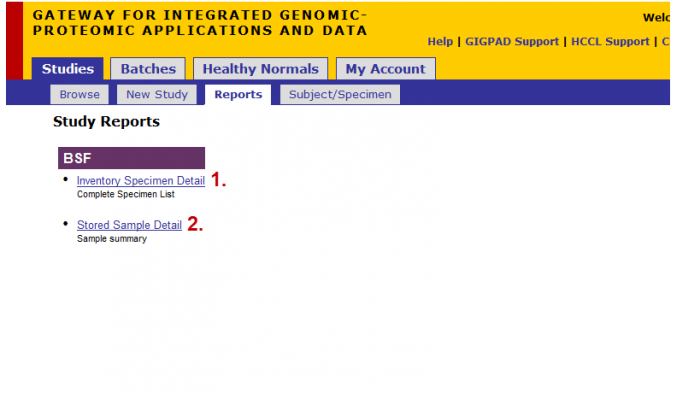BSF Reporting Help
Jump to navigation
Jump to search
The BSF reporting interface is designed to empower Principal Investigators by giving them direct access to the status of their samples. The main study reports screen displays the Reports that the investigators have access to.
Report overview
The reports available are:
- Inventory Specimen Detail: List of specimens and relevant data associated (status, volume, concentration, etc.)
- Stored Sample Detail: Summarized information of samples stored at the PCPGM.
Inventory Specimen Detail
This report allows the investigator to query the specimens that have been sent for processing/storage at the PCPGM.
Filters
- Study: samples are organized by the study to which they belong.
- Subject Id: Identifier given by the investigator. Partial match are acceptable in the filter.
- PCPGM ID: Identifier generated by the PCPGM upon specimen accession. All specimens from the same collection receive the same PCPGM Id. It’s format is <MMYY><PICode><NumericSequence> , example: 1213T0T00025. Partial matches are returned if submitted in the filter
- Status:
- In Process: Specimens have been received at the PCPGM and are being processed
- Stored: Specimens are stored at the PCPGM.
- Shipped: Specimens were shipped back to the investigator and are no longer at the center.
- Canceled: The services were canceled in the specimen.
- Consumed: Specimen was consumed.
- Disposed: Specimen was disposed.
- Received Date: Allows the user to filter by different ranges of dats when the specimens were received.
- Batch: The batch number in which the specimens were sent.
Report Data
- Specimen ID: Identifier generated by the PCPGM upon specimen creation. Consists of the PCPGM ID, parent container number and derivative sequence number.
- PCPGM ID: Identifier generated by the PCPGM upon specimen accession. All specimens from the same collection receive the same PCPGM Id of the format <MMYY><PICode><NumericSequence> , example: 1213T0T00025. The PCPGM Id is a sample identifier that can be used for requesting orders on stored samples.
- Subject ID: Customer provided identifier.
- Legacy ID: Previously generated GIGPAD identifier. Samples submitted after January 20th 2014 will not have this information.
- Received Date: Date the sample was accessioned at the center. Samples that were received prior to Jan 20th 2014 will not display this information. Although it is available and the center can get it to the investigator if required.
- Freeze Date: Date the specimen was put in long term storage. Samples that were received prior to Jan 20th 2014 will not display this information. Although it is available and the center can get it to the investigator if required.
- OD Purity
- OD Concentration
- RIN
- Status: described in the filters section of this document.
- Remaining Volume
- Barcode: Barcode assigned to the specimen by the PCPGM systems.
- Parent Type: The parent type from which the specimen was derived.
Stored Sample Detail
The stored sample detail report shows information about specimens with Stored or In Process status. The information is grouped by Sample Id. For each sample stored or in process this report shows the number of containers available for the collection, the sample type and the total DNA (for the appropriate specimen type).


